
It's nearly National Novel Writing Month, which means there is a 50,000-word mountain of a writing challenge starting in only a few weeks. For those ambitious writers who plan on reaching 50K words by the end of November, October—or Preptober—is the time to lay a solid story foundation and create a plan for consistent writing, whatever that may look like for you.
A Brief History
National Novel Writing Month began in 1999 and is an annual call for aspiring writers to challenge themselves to write the first draft of a novel in 30 days. NaNoWriMo became a non-profit in 2006 and has been a resource for finding inspiration, community, and support among aspiring authors. That being said, one doesn't necessarily need to join the challenge in an official capacity if that isn't your goal or if one has ethical concerns about the non-profit's recent statements regarding the use of AI. That's fair. Participate in National Novel Writing Month in the way that best suits your goals and/or lifestyle.
Rules:
- Writing starts at 12 a.m. Nov. 1 and ends at 11:59:59 p.m. on Nov. 30 local time.
- Prior to Nov. 1, planning and extensive notes are allowed.
- Starting the official writing early is not allowed.
- To "win," the work must be a minimum of 50K words before November ends. It can be a completed work or the first 50K words of the novel.
- Works can be any genre, theme, or language. They can even be fanfiction. (We're looking at you, fanfic authors on years-long hiatus.)
Start Prepping
First things first—create a space for your brainstorming and writing. Not every writing space will work for everyone, and not everyone has the ideal writing space. Do what you can to give yourself room to be creative. If that means clearing a space in a home office, claiming a comfortable spot at the kitchen table or couch, or just creating folders on your phone to write on the go, find what is feasible and works for you.
Comfortable? Great. Now you are sitting at your computer or phone or with a notebook, and the page is... blank. Where in the world do you start? Why are you writing again? What story—what universal truth or human experience—wants to get out of your head? Okay, okay. These are a little overwhelming existential questions. Let's break things down into smaller, more manageable pieces: idea, characters, story structure, plot, and world-building.
- Idea: What truth do you want to explore? What idea excites you? What are some general themes, character conflicts, or tropes that resonate with you?
- Trying to muscle through writing 50K words is challenging enough. Don't make it harder on yourself by trying to write something that does not interest you. Find your enthusiasm, find what inspires you, because your writing should excite you at some core place. Write first and foremost for yourself so you can be the biggest fan of your own work.
- Take time to just brain-dump on a blank page. It doesn't need to be organized—just get the ideas flowing. You may not keep all of them, but it is a start.
- Characters: Who is the focus of your story? What do they believe will make them happy? What lie do they believe about themselves, others, or the world? What do they fear? What lesson or truth do they need to learn? What is their relationship to the other characters in your story?
- Characters, their beliefs, and the choices they make drive the story. Yes, external things can happen to them, but what they do to cause these events or how they respond to these events is the story.
- Again, trying to muscle through 50K words is going to be challenging enough. Know your main characters and what makes them tick so you can outline your story with confidence.
- Story Structure: There are a few kinds of tried-and-true story structures, including but not limited to the Three Act Story, Freytag's Pyramid, The Hero's Journey, Dan Harmon's Story Circle, Fichtean Curve, Save the Cat Beat Sheet, and Seven Point Story Structure. Find one that works best for the story you want to tell. They are great guides to structure your story beats.
- A story structure is a solid base for your story outline. It is the framework of your plot and your characters' development, and it will give you the ability to write from point A to point B—ideally—without getting lost or blocked.
- Plot: What is happening in the world and why does it matter to your characters? What decisions do your characters make that affect them and other characters and move the story forward?
- Use one of the story structures to help shape these.
- World-building: What is your setting? How much does the setting affect your characters, their beliefs, and their actions? How does your world-building affect the tone of your story?
- Is your story set in a world much like ours or does yours have vast worlds and magic systems? Does your world work for the story you want to tell? Best to work that out before November comes around.
- Is your story set in a world much like ours or does yours have vast worlds and magic systems? Does your world work for the story you want to tell? Best to work that out before November comes around.
Setting a Writing Schedule
Writing 50,000 words in 30 days is a great—and very challenging—goal that requires consistency, dedication, and discipline. So, what does consistent writing look like to you? At minimum writers must write an average of 1,667 words per day. If weekends are the only available free time one has, you'll need to write 5,000 words for every Saturday and Sunday in November.
Remember! These 50,000 words aren't the final draft. It does not need to be perfect—it just needs to be a good start.
With that said, do you have to hit 50K words? No. Between school, jobs, and other responsibilities, not everyone has the time or opportunity to fully dedicate November to writing. That's okay! Only 10%-15% of participants finish National Novel Writing Month with 50,000 words written, but any writing you do will set you up for success.
- Helpful Reading
- Image
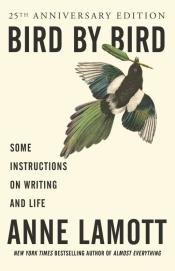
Bird by Bird by Anne Lamott
"Thirty years ago my older brother, who was ten years old at the time, was trying to get a report on birds written that he'd had three months to write. [It] was due the next day. We were out at our family cabin in Bolinas, and he was at the kitchen table close to tears, surrounded by binder paper and pencils and unopened books on birds, immobilized by the hugeness of the task ahead. Then my father sat down beside him, put his arm around my brother's shoulder, and said. 'Bird by bird, buddy. Just take it bird by bird.'"
With this basic instruction always in mind, Anne Lamott returns to offer us a new gift: a step-by-step guide on how to write and on how to manage the writer's life. From "Getting Started,' with "Short Assignments," through "Shitty First Drafts," "Character," "Plot," "Dialogue." all the way from "False Starts" to "How Do You Know When You're Done?" Lamott encourages, instructs, and inspires. She discusses "Writers Block," "Writing Groups," and "Publication." Bracingly honest, she is also one of the funniest people alive.
If you have ever wondered what it takes to be a writer, what it means to be a writer, what the contents of your school lunches said about what your parents were really like, this book is for you. From faith, love, and grace to pain, jealousy, and fear, Lamott insists that you keep your eyes open, and then shows you how to survive. And always, from the life of the artist she turns to the art of life.
Image
Big Magic: Creative Living Beyond Fear by Elizabeth Gilbert
Gilbert offers insights into the mysterious nature of inspiration. She asks us to embrace our curiosity and let go of needless suffering. She shows us how to tackle what we most love, and how to face down what we most fear. She discusses the attitudes, approaches, and habits we need in order to live our most creative lives. Balancing between soulful spirituality and cheerful pragmatism, Gilbert encourages us to uncover the “strange jewels” that are hidden within each of us. Whether we are looking to write a book, make art, find new ways to address challenges in our work, embark on a dream long deferred, or simply infuse our everyday lives with more mindfulness and passion, Big Magic cracks open a world of wonder and joy.
ImageNo Plot? No Problem!: A Low-stress, High-velocity Guide to Writing a Novel in 30 Days by Chris Baty
Chris Baty, founder of the wildly successful literary marathon known as National Novel Writing Month, has completely revised and expanded his definitive handbook for extreme noveling. Chris pulls from over 15 years of results-oriented writing experience to pack this compendium with new tips and tricks, ranging from week-by-week quick reference guides to encouraging advice from authors, and much more. His motivating mix of fearless optimism and practical solutions to common excuses gives both first-time novelists and results-oriented writers the kick-start they need to embark on an exhilarating creative adventure.
Image
Story Genius: How to Use Brain Science to Go Beyond Outlining and Writing a Riveting Novel by Lisa Cron
Following on the heels of Lisa Cron's breakout first book, Wired for Story , this writing guide reveals how to use cognitive storytelling strategies to build a scene-by-scene blueprint for a riveting story .
It’s every novelist’s greatest pouring their blood, sweat, and tears into writing hundreds of pages only to realize that their story has no sense of urgency, no internal logic, and so is a page one rewrite.
The prevailing wisdom in the writing community is that there are just two ways around this pantsing (winging it) and plotting (focusing on the external plot). Story coach Lisa Cron has spent her career discovering why these methods don’t work and coming up with a powerful alternative, based on the science behind what our brains are wired to crave in every story we read (and it’s not what you think).
In Story Genius Cron takes you, step-by-step, through the creation of a novel from the first glimmer of an idea, to a complete multilayered blueprint—including fully realized scenes—that evolves into a first draft with the authority, richness, and command of a riveting sixth or seventh draft.
Image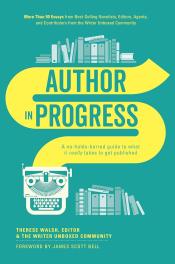
Author in Progress: A No-Holds-Barred Guide to What it Really Takes to Get Published edited by Therese Walsh
Empower Your Writing Through Craft and Community!
Writing can be a lonely profession plagued by blind stumbles, writer's block, and despair—but it doesn't have to be. Written by members of the popular Writer Unboxed website, Author in Progress is filled with practical, candid essays to help you reach the next rung on the publishing ladder. By tracking your creative journey from first draft to completion and beyond, you can improve your craft, find your community, and overcome the mental barriers that stand in the way of success.
Author in Progress is the perfect no-nonsense guide for excelling at every step of the novel-writing process, from setting goals, researching, and drafting to giving and receiving critiques, polishing prose, and seeking publication.
You'll love Author in Progress if...
• You're an aspiring novelist working on your first book.
• You're an experienced veteran looking for ways to enhance your career and connect with your writing community.
• You've finished your first draft and want to know the next steps.
• You're seeking clear, effective advice about publication-from professionals who are "down in the trenches" every day.
What's Inside...
Author in Progress
• More than 50 essays from best-selling authors, editors, and industry leaders on a variety of writing and publishing topics.
• Advice on writing first drafts, conducting research, building and fostering community, seeking critique, revising, and getting published.
• An encouraging approach to the writing and publishing process, from authors who've walked this path.
Image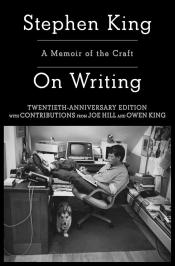
On Writing: A Memoir of the Craft by Stephen King
Part memoir, part master class by one of the bestselling authors of all time, this superb volume is a revealing and practical view of the writer's craft, comprising the basic tools of the trade every writer must have. King's advice is grounded in his vivid memories from childhood through his emergence as a writer, from his struggling early career to his widely reported near-fatal accident in 1999—and how the inextricable link between writing and living spurred his recovery. Brilliantly structured, friendly and inspiring, On Writing will empower and entertain everyone who reads it—fans, writers, and anyone who loves a great story well told.
Image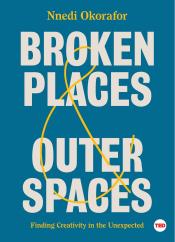
Broken Places & Outer Spaces: Finding Creativity in the Unexpected by Nnedi Okorafor
A powerful journey from star athlete to sudden paralysis to creative awakening, award-winning science fiction writer Nnedi Okorafor shows that what we think are our limitations have the potential to become our greatest strengths.
Nnedi Okorafor was never supposed to be paralyzed. A college track star and budding entomologist, Nnedi’s lifelong battle with scoliosis was just a bump in her plan—something a simple operation would easily correct. But when Nnedi wakes from the surgery to find she can’t move her legs, her entire sense of self begins to waver. Confined to a hospital bed for months, unusual things begin to happen. Psychedelic bugs crawl her hospital walls; strange dreams visit her nightly. Nnedi begins to put these experiences into writing, conjuring up strange, fantastical stories. What Nnedi discovers during her confinement would prove to be the key to her life as a successful science fiction author: In science fiction, when something breaks, something greater often emerges from the cracks.
In Broken Places & Outer Spaces, Nnedi takes the reader on a journey from her hospital bed deep into her memories, from her painful first experiences with racism as a child in Chicago to her powerful visits to her parents’ hometown in Nigeria. From Frida Kahlo to Mary Shelly, she examines great artists and writers who have pushed through their limitations, using hardship to fuel their work. Through these compelling stories and her own, Nnedi reveals a universal truth: What we perceive as limitations have the potential to become our greatest strengths—far greater than when we were unbroken.
A guidebook for anyone eager to understand how their limitations might actually be used as a creative springboard, Broken Places & Outer Spaces is an inspiring look at how to open up new windows in your mind.
Image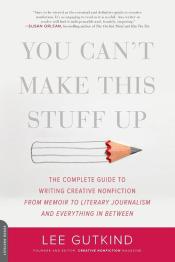
Whether you're writing a rags-to-riches tell-all memoir or literary journalism, telling true stories well is hard work. In You Can't Make This Stuff Up , Lee Gutkind, the go-to expert for all things creative nonfiction, offers his unvarnished wisdom to help you craft the best writing possible.
Frank, to-the-point, and always entertaining, Gutkind describes and illustrates every aspect of the genre. Invaluable tools and exercises illuminate key steps, from defining a concept and establishing a writing process to the final product. Offering new ways of understanding the genre, this practical guidebook will help you thoroughly expand and stylize your work.
Image
Your Life is a Book: How to Craft & Publish Your Memoir by Brenda Peterson
Whether you're writing your memoir for self-exploration, to leave a legacy, or for publication, Your Life Is A Book takes you on a step-by-step journey from concept to completion. This writer's guide to the memoir is rich with insight, advice, storytelling, and encouragement. Memoirist Brenda Peterson and New York literary agent, Sarah Jane Freymann team up to share with you their expertise in writing and publishing your life story. Your Life Is A Book offers accessible and inspiring writing techniques, exercises, publishing tips, and real-life stories of other authors whose memoirs have transformed their life and work. The book is also a practical guide to both traditional and indie publishing, including interviews with professional editors, publishers, critics, and memoirists. Every life is remarkable in its own way, but this book shows you how to write a book that others will want to read and share.
Image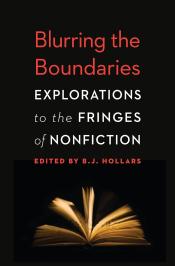
Blurring the Boundaries: Explorations to the Fringes of Nonfiction edited by B. J. Hollars
Contemporary discussions on nonfiction are often riddled with questions about the boundaries between truth and memory, honesty and artifice, facts and lies. Just how much truth is in nonfiction? How much is a lie? Blurring the Boundaries sets out to answer such questions while simultaneously exploring the limits of the form. This collection features twenty genre-bending essays from today’s most renowned teachers and writers—including original work from Michael Martone, Marcia Aldrich, Dinty W. Moore, Lia Purpura, and Robin Hemley, among others. These essays experiment with structure, style, and subject matter, and each is accompanied by the writer’s personal reflection on the work itself, illuminating his or her struggles along the way. As these innovative writers stretch the limits of genre, they take us with them, offering readers a front-row seat to an ever-evolving form. Readers also receive a practical approach to craft thanks to the unique writing exercises provided by the writers themselves. Part groundbreaking nonfiction collection, part writing reference, Blurring the Boundaries serves as the ideal book for literary lovers and practitioners of the craft.
Other Free Resources
The Great Courses: "How to Write Best-Selling Fiction" Series with James Scott Bell
Get a comprehensive, eye-opening, and illuminating survey of the entire writing process, as well as a full breakdown of how dozens of best-selling authors have implemented best practices in their own writing. As an aspiring author, you will gain a wealth of tools that will not only improve your ability to write but will also increase your enjoyment of the craft.
The Great Courses: "Writing Great Fiction: Storytelling Tips and Techniques" Series with James Hynes
Writing great fiction isn't a gift reserved for a talented few - the craft of storytelling can be learned. Even if you don't dream of penning the next Moby-Dick, you'll enjoy exploring the elements of fiction. A wealth of exercises will get you writing so that you can practice the many techniques you learn. From evoking a scene to charting a plot, get a master class in storytelling.
Posted as a playlist on YouTube, author Brandon Sanderson offers lectures on creative writing.